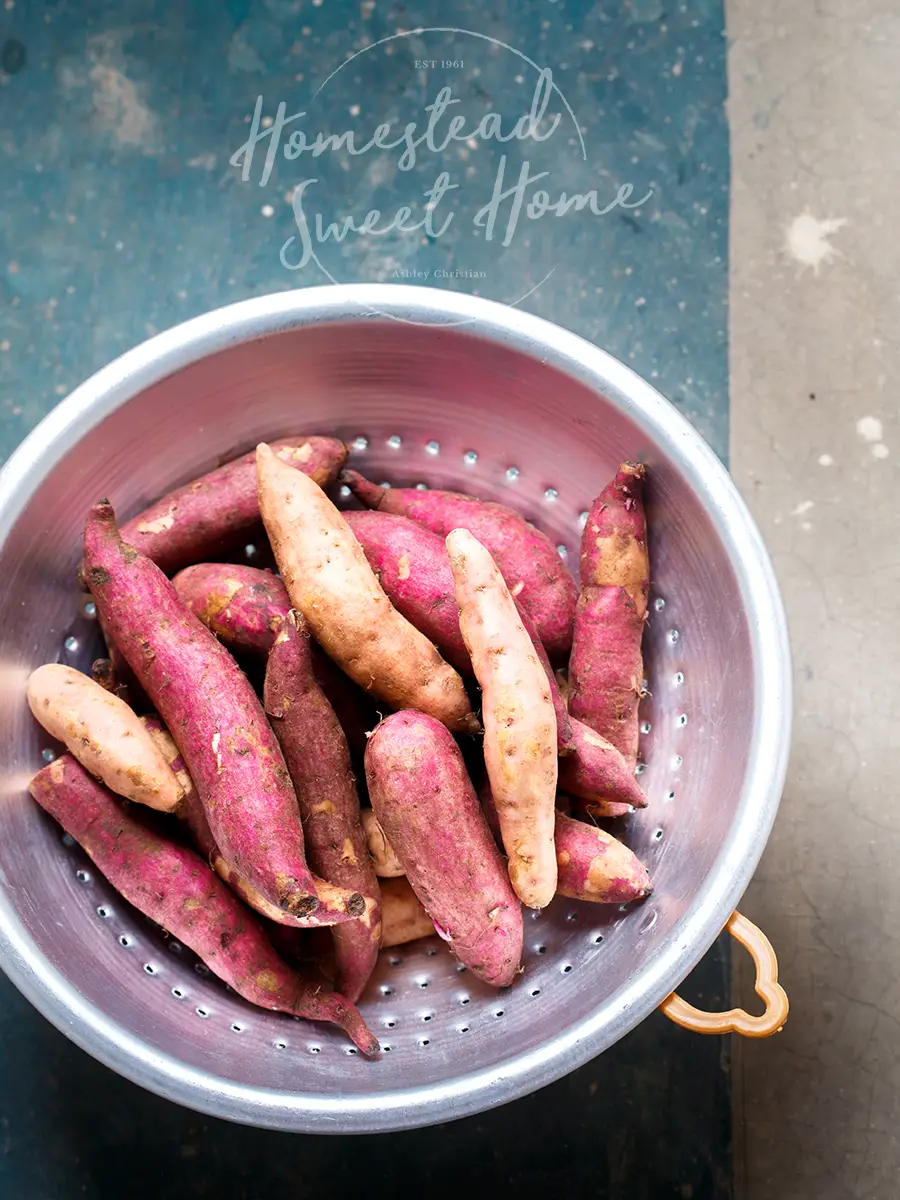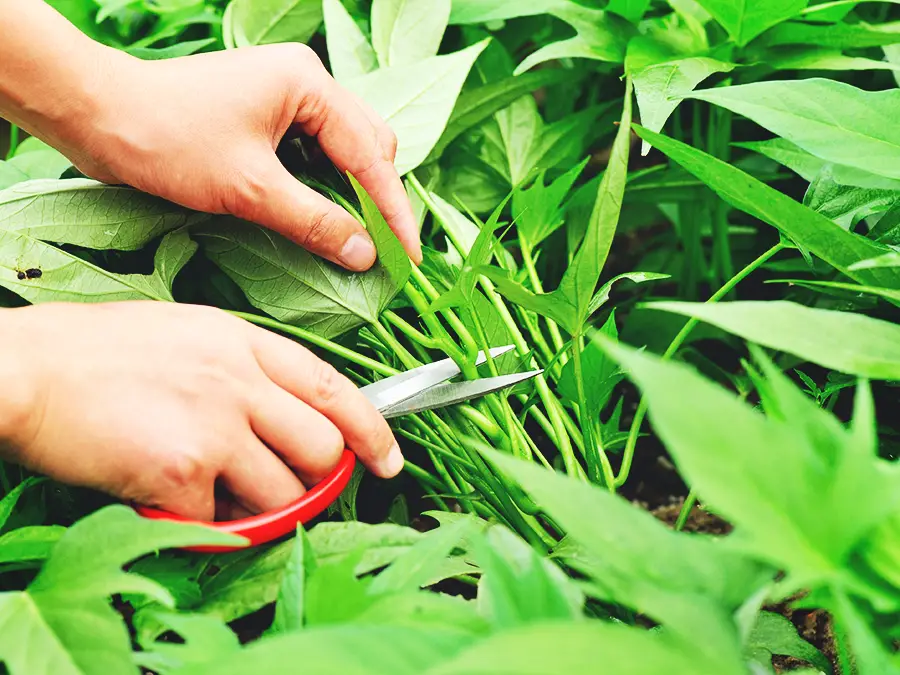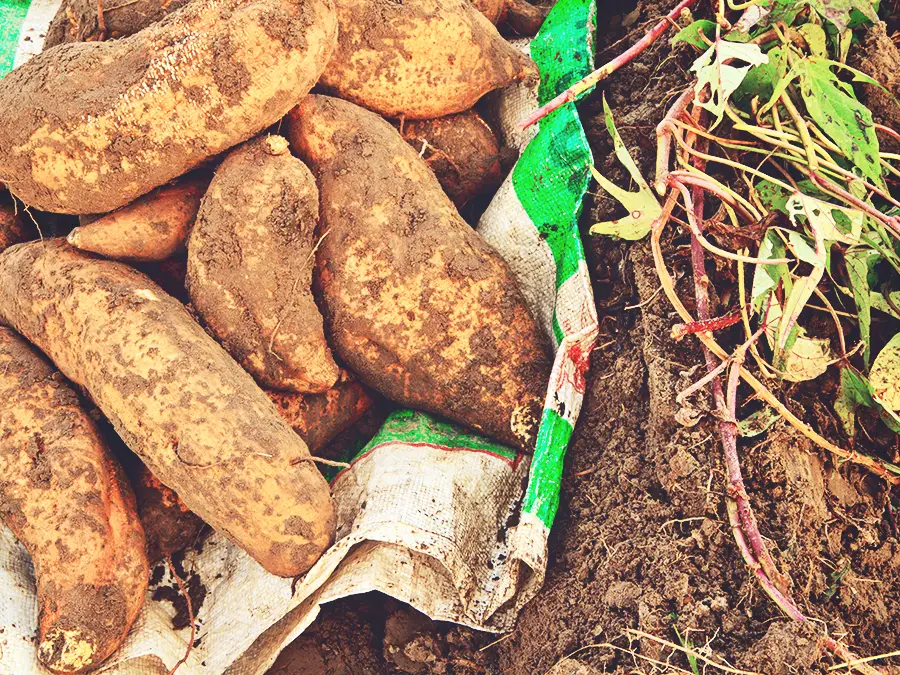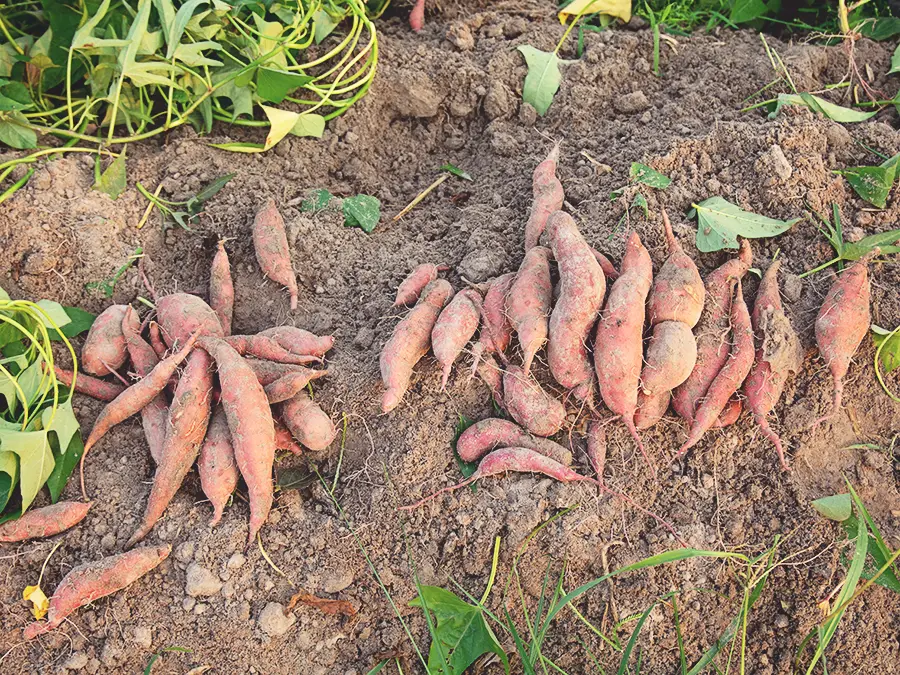When to Harvest Sweet Potatoes + 4 Must-Do Sweet Potato Gardening Tips

The sweet potato is a tropical heat-loving plant in the morning glory family that requires 3 to 4 months of warm weather to develop and be ready for harvesting. You know when to harvest sweet potatoes by the ends and leaves beginning to turn yellow, or before your first fall frost. Sweet potatoes take 90 to 120 days of warm weather to mature and are ready to harvest as soon as you feel they are big enough to eat. If you leave them in longer, they will grow larger and more nutritious.
Because sweet potatoes require so much warm weather, they can be difficult to grow in more northern climates, and knowing when to harvest sweet potatoes is important to keep them from rotting in the first fall frost. Let’s learn the basics of growing sweet potatoes in your home garden, plus four must-do sweet potato gardening tips.
Sweet Potato Quick Facts
- Botanical Name—Ipomoea batatas
- Common Names—Sweet potato, sometimes referred to as yams, though they are not truly yams
- Plant Type—treated as an annual in North America, though it can be a perennial in tropical climates
- Size—roots are 4 to 6 inches, and vines can grow up to 20 feet
- Spacing—12 to 18 inches apart, plant slips deep enough to cover roots and stem up to just below the leaves, and plant rows 3 feet apart
- Ideal Climate—full sun, generally southern states, and ground temps above 60 F, though they can be grown in the north with modifications
- Can it Be Started Indoors and Transplanted—yes
- Taste—mild, starchy, sweet
- Growth—90 to 120 days to maturity
- Harvesting—they are ready when ends of leaves and vines begin to turn yellow, or before the first fall frost, roots need to be cured in a warm well-ventilated area for 10 days prior to eating or storing
How to Plant Sweet Potatoes
Because sweet potatoes are very frost sensitive you’ll want to start them in the garden 3 to 4 weeks after your last frost date. From this date, you can count around 100 days to know when to harvest sweet potatoes, but this varies by the variety of sweet potatoes you planted and your weather.
Sweet potato plants are not started from seeds but from slips, which are cuttings from the sweet potato vine. You can find sweet potato slips at your local nursery, in seed swapping groups, or ordering them from a company online.
Can I Grow Slips From Sweet Potatoes?
Yes, you can grow sweet potato plants from a store-bought sweet potato, it will just take some time. It’s best to choose the healthiest looking organic sweet potato you can find. It would also be nice to know what variety of sweet potatoes you are propagating. I’ve found upscale or natural grocery stores generally have better information about the variety of sweet potatoes you are buying.
The process of growing sweet potato plants from a sweet potato takes about 4 to 6 weeks. So you can begin this process about 3 weeks before your last frost date, and plant directly in the ground or in raised beds when they’re ready. You could also start the process of growing your sweet potatoes in the fall, and keep the slips growing in pots until they’re ready to go outside.
To grow plants from your sweet potatoes, you can either plant them inside in well-draining soil or propagate them half submerged in jars of water. Your plants will need it warm, between 75 to 80 degrees to grow well, so you may want to consider a heated seed mat if your home isn’t naturally warm enough.
When your sweet potato slips have grown you can remove them from the roots and keep them in jars of water without the leaves touching, or in the soil until they are ready to plant in the garden.

Can I Grow Sweet Potatoes In a Cold Climate?
Yes, you can grow sweet potatoes in a cold climate with these 4 must-do sweet potato gardening tips.
- Look for fast-growing varieties that are ready to harvest in 80 to 90 days and are cold-hardy. The Beauregard, Centennial, and Georgia Jet are all excellent varieties for colder climates with shorter growing seasons.
- Get an earlier start on your growing season by warming your ground up with black plastic mulch. The black plastic mulch or covering can give you a few weeks earlier start on the growing season and help your plants take off sooner. You can also keep this mulch on throughout the whole season.
- My grandfather recommends using a ground thermometer rather than going by air temperatures. As soon as the ground is consistently 60 F you can plant your sweet potato slips.
- The first few weeks after planting, use garden fabric to keep your slips covered and help protect them from lingering chilly spring temperatures.
How Do I Prepare the Ground for Planting?
Slips—Plant your slips so they cover the entire root and stem, going just up to the leaves. You’ll want to space them 12 to 82 inches apart and leave 3 feet between the rows because sweet potatoes love to vine. You can get up to five sweet potatoes from one plant.
Sweet potatoes thrive on 8 to 10 hours of direct sunlight each day so they need to be planted in an area with full sun. You can start your slips indoors in a space with plenty of indirect sunlight. But once they’ve been hardened off and moved outdoors, you’ll need to transplant them in an area with full sun.
Watering—When you first plant your sweet potato slips, whether in the ground or in containers indoors, you’ll need to water them frequently and don’t let the soil dry out. Anywhere from twice a day, to every other day, is good for slips. Or you could also keep them in jars of water without the leaves touching. If you do this, make sure to change the water every few days.
It’s best to water an established garden more deeply and space waterings further apart rather than daily. In general, gardens can be soaked with 1 inch of water or rain once a week. If you get rain, you only need to supplement whatever amount of water is left up to 1 inch of rain. Sweet potatoes are actually one of the more drought-hardy plants.
Soil—Sweet potato plants need good drainage, so you’ll want to make sure you have a good mix of organic compost and high-quality topsoil. Perfect soil should be able to pass the squeeze test. If you squeeze it in your hand, it will hold together. But if you run your fingers through it, it will fall apart.
If your soil is too hard, consider amending it with compost to allow for better drainage and oxygen. If you are using raised beds or tilling soil into your inground garden bed, try one of these soil recipes. Remember, your garden will only be as good as your soil.
There are many different recipes for the best garden soil, but the two most popular are:
- 60/30/10—60% topsoil, 30% compost, and 10% potting soil (this is actually a soilless blend of peat moss, vermiculite, and/or perlite.
- 50/50—50% topsoil and 50% compost
When buying your topsoil, you’ll need to do a little sleuthing to make sure it’s good quality. Signs of high-quality topsoil are:
- Regionally sourced ingredients listed on the bag
- Nationally recognized compost certification on the bag
- Passes the squeeze test, sticks together when squeezed, but then falls apart again when you run your fingers through it
- Is not fill-dirt that some companies mistakenly call top-soil
When to Harvest Sweet Potatoes
When to harvest sweet potatoes depends largely on the variety you chose, and your climate. Signs you’ll want to look for are the ends of vines and leaves turning yellow. You can also gently dig to check on the size of your sweet potato starting at 80 days for fast-growing varieties, or 100 days for average growing varieties.
Sweet potatoes are very cold sensitive, and if left in the ground for the first fall frost, they will rot quickly. Because of this, it’s important to harvest them before your first frost. Sweet potatoes will continue to grow and gather more nutrients the longer they are left in the ground. So even if they are technically ready, you can leave them longer to grow bigger, as long as you get to them before the frost does.
If you harvest sweet potatoes too early, they just won’t be very big. We recommend leaving them in the ground for as long as you can, or until they’ve reached the perfect size you want them at. Dig gently around to test the size of the sweet potato, before you go digging them all out.
How to Harvest Sweet Potatoes
Sweet potatoes are ready to harvest when the ends start turning yellow, or just before the first fall frost if you live where there are shorter growing seasons. When you’ve determined when to harvest sweet potatoes, you can cut away the vines from the base of the plant to make digging easier. This is a good time to save slips from your vines to over-winter and use next season. Make sure to use sharp scissors or garden snips that you’ve sterilized with rubbing alcohol when harvesting slips.
To avoid damaging the delicate roots, use a digging fork or pitchfork, and loosen the soil in an 18-inch circle around your plant. Gently pull up the base of your plant, and dig out the sweet potatoes with your hands. Each plant can produce around five sweet potatoes.
The flesh of your newly harvested sweet potatoes will be very soft and easily bruised or damaged, so you’ll want to be gentle with them. Any obviously damaged sweet potatoes you can carry to the kitchen to use in baking in sweetened dishes that you plan to cook right away. Otherwise, add your heavily damaged sweet potatoes to the compost pile.

Can You Eat Sweet Potatoes as Soon as You Harvest Them?
Sweet potatoes need about ten days to cure before they are ready to eat. If you eat them right after harvesting them, they will taste more bitter and won’t have that classic sweetness to them. To cure your sweet potatoes, choose a very warm spot, 80 to 90 F is ideal, so you can use a heater indoors, a greenhouse with a heater, or outside it a shaded spot protected from the rain if you still have warm daytime temperatures in your area.
Don’t wash your sweet potatoes, but simply shake the dirt off of them. You’ll want them well ventilated so spread them out for maximum airflow, and use a fan if they are in a small space. Give your sweet potatoes 10 to 14 days to cure before eating or storing them.
How to Store Sweet Potatoes
Cured sweet potatoes can keep for up to six months if they are stored at around 60 degrees with high humidity. A root cellar or winter greenhouse is the ideal place to store them. If you don’t have either you can store them in an indoor pantry, but they won’t last quite as long. They won’t keep long-term in the refrigerator.
Before storing your sweet potatoes, discard any that are bruised. To protect them even further, you can wrap each one in a sheet of newspaper and store them in a bin. Sweet potatoes bruise easily so be careful when you’re handling them.

How Do I Eat Sweet Potatoes?
After you’ve learned when to harvest sweet potatoes and you’re ready to eat them, they can be baked, fried, boiled, microwaved, and even eaten raw. To get the most sweetness out of them, you’ll want to bake them.
Baked—set on parchment paper, poke with a fork, and bake at 425 F for 40-50 minutes until they are soft when squeezed with a hot pad. You could also cut them up like fries, spray them with cooking oil, and season and bake them for sweet potato fries.
Fried—grate sweet potatoes and add them in separate handfuls to a well oiled pan or griddle, add more oil on top of each pile and let it melt in (I prefer coconut oil or butter), cook on medium and flip after 5 minutes, then cook the other side, now you have sweet potato hash browns. If the pile isn’t working, you can stir them around and fry them as a big heap, stirring regularly.
Microwaved—the quickest way to cook a sweet potato for a fast lunch. Place one sweet potato in the microwave and cook on high for 4 minutes. Interestingly the sugar count is lower and the taste not as sweet when cooked in the microwave compared to cooked slowly in the oven.
Raw—raw sweet potatoes are very low on the glycemic index and can be grated and added to salads.
Ready to get started gardening or need help troubleshooting your own garden? Check out The Complete Guide to Gardening at Home + 5 Beginner Mistakes to Avoid.
You can also learn more about the Best Vegetables to Grow from 60 gardeners, including myself, in this round-up article.
How about you, have you grown sweet potatoes before? Which variety have you liked the best? Let us know your experience in the comments below.


Leave a Reply